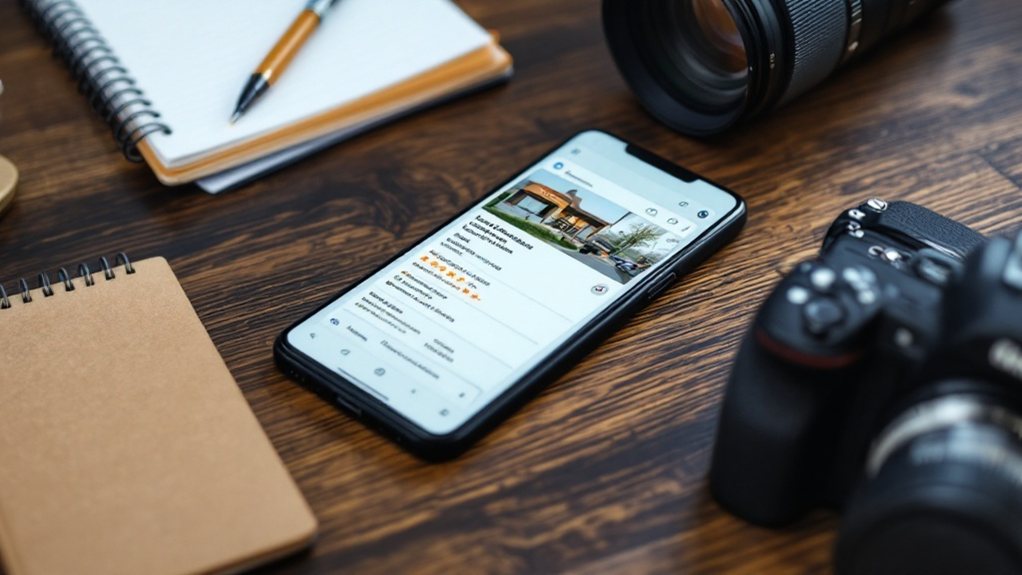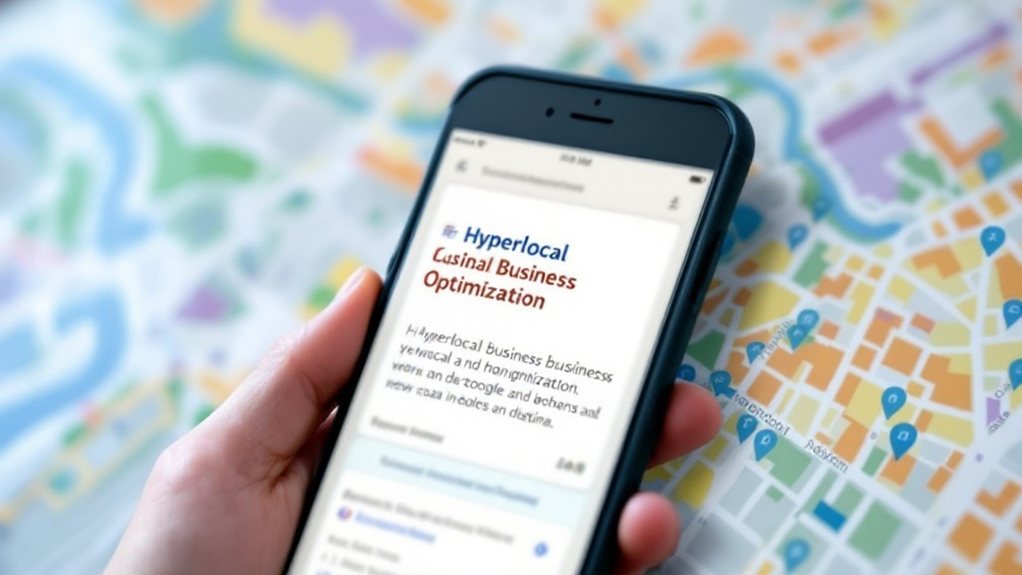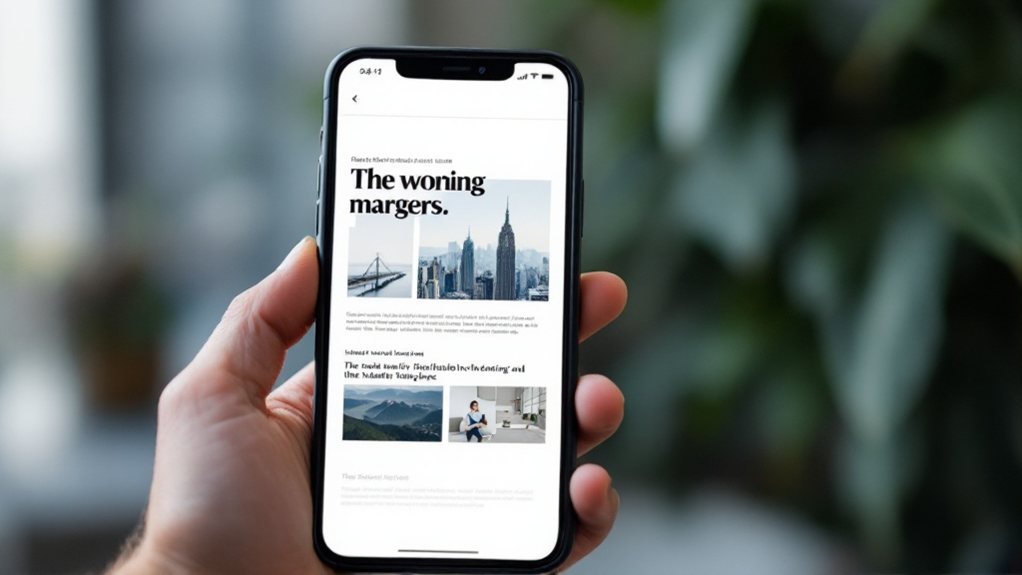To optimize hyperlocal blog posts for mobile search, you'll want to leverage neighborhood-specific keywords, create mobile-friendly content layouts, and implement Accelerated Mobile Pages (AMP). Ensure your local business listings are complete and consistent, while boosting page load speeds. Craft engaging location-based content and build local citation and backlink profiles. By utilizing data-driven hyperlocal insights and monitoring mobile performance, you can drive visibility and engagement with your target neighborhood audience. Dive deeper to uncover more strategies for optimizing your hyperlocal content for mobile users.
Optimize Local Business Listings

Optimizing local business listings is critical for enhancing your online visibility and attracting potential customers. Claim and manage your Google Business Profile to update your business information and improve search rankings. Ensure your business details, including address, phone number, and category, are complete and accurate. Regularly update your profile with current hours, services, and contact info for better visibility. Use high-quality visuals to engage customers, and maintain consistent business name, address, and phone number (NAP) across all listings. List your business on relevant directories and industry-specific sites to boost online presence. Manage your listings efficiently using visibility tools and showcase your community involvement to enhance credibility.
Leverage Neighborhood-Specific Keywords

When conducting keyword research for your hyperlocal blog, don't overlook the power of neighborhood-specific terms. Leverage tools like Google Keyword Planner, Ubersuggest, and Google Trends to uncover relevant keywords that reflect your local audience's search patterns. Use terms like “home inspection services in [neighborhood]” and incorporate local landmarks to create targeted keyword phrases. Embedding neighborhood names in your content can further boost relevance and visibility. Ensure keywords appear naturally throughout, including image alt texts. Focus on micro-local keywords to improve ranking and attract qualified leads. Conduct competitor analysis and leverage social media to identify community-specific language. Develop content that addresses local search queries and aligns with voice search patterns to provide value to your neighborhood-based readers.
Create Mobile-Friendly Content Layouts

Creating mobile-friendly content layouts is essential for delivering an optimal user experience on small screens. Understand your audience demographics to tailor the layout to their needs. Understand user behavior on mobile to ensure content is easy to digest quickly. Optimize for touch interactions by increasing tap target sizes and positioning key elements within thumb reach. Utilize responsive design to ensure adaptability across devices. Enhance navigation with intuitive structures and prioritize important information. Focus on performance by optimizing images and ensuring cross-device compatibility. By following these principles, you can create mobile layouts that engage your hyperlocal audience and improve their search experience.
Implement Accelerated Mobile Pages (AMP)
Optimizing your hyperlocal blog for mobile search can involve implementing Accelerated Mobile Pages (AMP). AMP helps enhance the mobile user experience by improving your website's loading times. Leveraging AMP technology can boost your content's visibility and engagement in mobile search results. By following AMP guidelines, you can create fast-loading, mobile-optimized pages that deliver a seamless user experience, potentially improving your search rankings and driving more traffic to your hyperlocal content.
Leverage AMP Technology
Implementing Accelerated Mobile Pages (AMP) can significantly enhance the performance and visibility of your hyperlocal blog posts. With AMP, your pages can load faster, improving your Core Web Vitals and aligning with Google's mobile-first indexing strategy. AMP's pre-rendering and caching features ensure your content is readily available, reducing bounce rates and increasing user engagement. Moreover, the distinct lightning bolt icon in search results can boost click-through rates, driving more traffic to your hyperlocal content. AMP reduces load on servers, benefiting entire site. By optimizing your code and leveraging AMP's mobile-friendly capabilities, you can outperform your competition and better serve your local audience.
Enhance Mobile User Experience
Enhancing the mobile user experience is crucial for the success of your hyperlocal blog. By implementing Accelerated Mobile Pages (AMP), you can dramatically improve page load times, boost user engagement, and enhance your content's discoverability. With over 59% of global web traffic coming from mobile devices, AMP significantly reduces bounce rates and improves session times by serving lightning-fast mobile pages. Your AMP-enabled content is eligible for the Google AMP carousel, increasing visibility in search. With a clean, streamlined layout, AMP pages offer a simplified design that prioritizes user experience over unnecessary elements. While AMP doesn't directly impact SEO, the improved mobile experience can indirectly benefit your search rankings. Ensure your navigation, design, and content are optimized for mobile users to further enhance their experience on your hyperlocal blog.
Improve Website Loading Times
Improving website loading times is paramount for the success of your hyperlocal blog. Implementing Accelerated Mobile Pages (AMP) can significantly boost your page speed. AMP optimizes content, removes non-essential elements, and leverages specialized HTML tags to accelerate rendering. This leads to improved Core Web Vitals, such as Largest Contentful Paint, crucial for search rankings. AMP's mobile-first approach aligns with Google's indexing priorities, ensuring your content is optimized for mobile users. Moreover, AMP reduces data consumption, making your blog more efficient on slower networks. With over 1.5 billion AMP pages created, you can leverage this technology to enhance your mobile user experience and drive more traffic through faster load times.
Enhance Page Load Speeds
Ensuring your hyperlocal blog loads quickly on mobile devices is crucial. Page speed is a measurement of how fast the content on a page loads. Leverage caching to store copies of web files, reducing server load and improving page loading times. Use content delivery networks (CDNs) to distribute static content from geographically diverse locations, reducing latency. Enable parallel processing to handle multiple server requests concurrently. Regularly update server software to ensure compatibility with the latest technologies. Compress and cache content specifically for mobile devices to improve load times.
- Leverage caching to reduce server load
- Use CDNs to distribute static content
- Enable parallel processing for faster response
- Update server software regularly
- Compress and cache for mobile devices
Improve Local Business Review Strategies
Responding promptly to customer reviews, both positive and negative, builds trust with potential clients. Reviews validate the legitimacy and credibility of the business for potential customers. Leveraging authentic testimonials from satisfied customers can effectively showcase your business's strengths. Implementing a review monitoring system allows you to stay on top of feedback and address any concerns in a timely manner.
Respond Promptly
Why not start by addressing customer concerns swiftly? Timely responses boost customer satisfaction and enhance your business's reputation. After all, four out of five consumers use local search, and prompt engagement can make all the difference. Plus, 78% of local mobile searches lead to purchases, highlighting the importance of immediate action. Asking customers for reviews is an effective way to boost local search optimization and online reputation.
- Regularly monitor review sites and social media for feedback.
- Encourage constructive dialogue to improve your services.
- Consistent engagement with reviews builds credibility and trust.
- Respond to all reviews – positive or negative – for local SEO benefits.
- Leverage visual content in your review responses to strengthen your brand.
Leverage Testimonials
Testimonials are a powerful tool for enhancing your local business's credibility. With 85% of consumers trusting local reviews, leveraging customer feedback can build trust and influence purchase decisions. Incorporate testimonials into your blog posts to boost credibility and engagement. Emphasize local aspects to attract regional customers, and use relevant keywords to improve search visibility. When optimizing for mobile, ensure testimonials are concise, visually appealing, and tailored to local relevance. Sharing authentic customer stories can be more compelling than statistics, so focus on problem-solving and highlight how reviews led to solutions. Integrating local SEO strategies, like using community involvement and service quality in testimonials, can further amplify your local appeal.
Implement Review Monitoring
Keeping a close eye on your local business reviews can make all the difference. Reviews impact 94% of consumers and 88% influence purchase decisions. Boost your conversion rate by 35% with regular review monitoring and timely responses. Reviews also play a vital role in local SEO, making up 17% of local pack ranking factors. Customers expect a response within 7 days to maintain trust.
- Aggregate reviews from various platforms for centralized monitoring.
- Analyze review sentiment to understand customer satisfaction.
- Set up alerts to respond to new reviews promptly.
- Develop guidelines for consistent, empathetic responses.
- Track review metrics to assess the effectiveness of your strategy.
Craft Engaging Location-Based Content
Crafting engaging location-based content is an essential strategy for captivating local audiences. Targeting topics like local events, hidden gems, and must-visit spots can effectively engage your community. Incorporate location-specific keywords to improve search rankings, and personalize content to increase relevance. Leverage local references to enhance authenticity, and keep content fresh by updating it seasonally or during major events.
| Targeted Topics | Location-Specific Keywords | Personalized Content |
|---|---|---|
| Local Events | Long-tail & Head Terms | Geographic Relevance |
| Hidden Gems | Include Location | Resonance |
| Best Destinations | Optimize for Search | Increased Engagement |
Utilizing location-based technologies, optimizing for mobile, and adhering to data privacy regulations can further elevate your hyperlocal blog content.
Build Local Citation and Backlink Profiles
Building a robust local citation and backlink profile is crucial for optimizing your hyperlocal blog's visibility in search results. Begin by identifying key directories like Google Business Profile, Yelp, and Bing Places, and verify your business listings to ensure consistent NAP (Name, Address, Phone Number) information. Focus on industry-specific platforms to target your audience effectively. Utilize tools like Moz Local to simplify citation management. Prioritize high-quality, authoritative directories, and engage with local bloggers and journalists for valuable unstructured citations. Leverage guest posting, press releases, and local business partnerships to build a diverse backlink profile. Monitoring and optimizing your citations and backlinks over time will enhance your local SEO.
- Identify key directories and verify listings
- Target industry-specific platforms
- Manage citations with dedicated tools
- Earn unstructured citations from local sources
- Build a diverse, high-quality backlink profile
Utilize Data-Driven Hyperlocal Insights
Leveraging data-driven hyperlocal insights is paramount for optimizing your blog's visibility in local search. Analyze location-based keywords to identify the most relevant terms for your target audience. Capitalize on micro-moment search trends, as mobile users frequently seek immediate local solutions. Examine geographic search patterns to enhance the relevance and rankability of your content. Utilize tools like Google Trends to uncover valuable data on local search queries and emerging "near me" trends. Ensure consistent name, address, and phone (NAP) information across your online platforms to boost your local search credibility. Optimizing for featured snippets can further improve your visibility in hyperlocal search results. Embrace a data-driven approach to tailor your blog content and attract the right local audience.
Monitor and Optimize Mobile Performance
Monitoring your mobile website's performance metrics is crucial for delivering an exceptional user experience. Analyze page load times, resource utilization, and user engagement to identify areas for improvement. Optimize your code, resources, and network to ensure your hyperlocal blog posts load quickly and engage mobile readers.
Analyze Mobile Website Data
Analyzing your mobile website data is crucial for optimizing its performance. Leverage tools like NetBiscuits to gain insights into your mobile visitors' device capabilities. Fullstory's session recording and heatmaps can help you identify friction points. BrowserStack allows you to test your website's performance across various mobile devices. Google Webmaster Tools provides valuable data on mobile site crawl errors and issues. Utilize WebTrends for real-time campaign reports and social metrics specific to your mobile website.
- Analyze device capabilities and user interactions
- Identify friction points through session recording and heatmaps
- Test mobile website performance across devices
- Monitor mobile site crawl errors and issues
- Track real-time campaign reports and social metrics
Enhance User Experience Metrics
Effective mobile user experience optimization starts with tracking key metrics. Monitor your conversion rate, bounce rate, and time spent on page to understand user engagement. Session interval and customer satisfaction (CSAT) surveys provide insights into user retention and satisfaction. Leverage tools like Google PageSpeed Insights, BrowserStack, and Dynatrace to assess site speed and address performance issues. Optimize image sizes with TinyPNG and ensure mobile-friendliness with Google's Mobile-Friendly Test. For your mobile app, monitor retention rate, average revenue per user (ARPU), daily active users (DAU), and churn rate. Prioritize a smooth load time to deliver a seamless user experience. Applying these best practices will enhance your mobile optimization efforts.
Optimize Content for Mobile
While crafting engaging mobile content, it's crucial to prioritize optimization for seamless user experiences. Ensure your pages load lightning-fast by compressing images and videos, minimizing JavaScript and CSS, and leveraging a content delivery network. Utilize tools like PageSpeed Insights to identify areas for improvement. Moreover, consider implementing lazy loading to enhance initial load times.
To deliver the best mobile experience, your content should be:
- Concise and scannable with short paragraphs and bullet points
- Tailored to specific neighborhoods or regions for improved local relevance
- Designed with touch-friendly interactive elements for easy navigation
- Highly contrasted for readability, even in outdoor settings
- Regularly audited and updated to maintain performance and relevance
